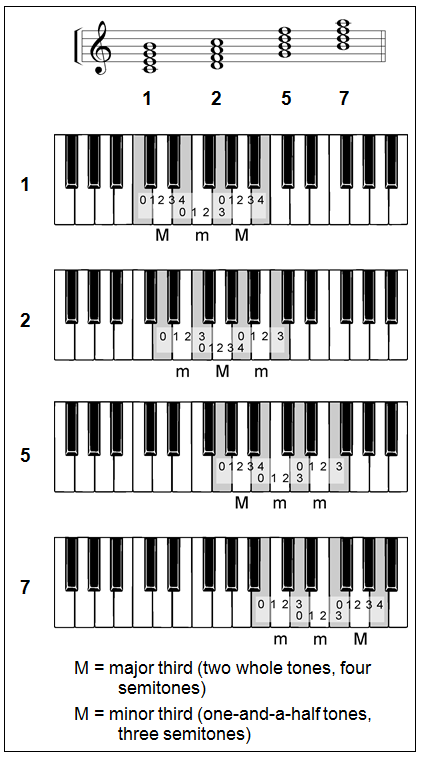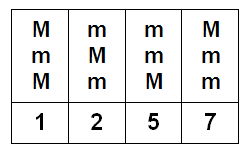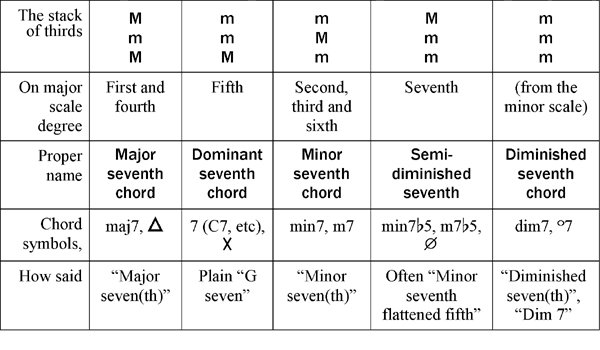Patreon CHORDS 101 Series
Seventh Chords
- Page One -
This series of Musicarta web pages will show you the best way to get to know and practice the five basic types of seventh chord.
For your music to be interesting, you must know and use seventh chords. Seventh chords make music ‘move’. Seventh chords are four note chords, and the extra note makes the chord want to move to another chord.
All sophisticated popular music, and jazz in particular, depends on seventh chords for an interesting sound. Modern keyboard players are expected to be able to build any seventh chord on any root from just a chord symbol. The Musicarta Seventh Chords keyboard drill in this module will show you how to practice that skill efficiently.
Seventh chords are also essential for understanding the Circle of Fifths, the ultimate chord progression and the heart of jazz harmony.
|
Seventh chords nav |
The seventh chords
Here is the teaching video for the first part of this module. It shows you how the find the seventh chords and count the semitones to find four of the five types.
You can either watch the video and then catch up on the written notes, or the other way round.
Seventh chords are four-note chords – the triads you already know (major, minor or diminished) with another note a major or minor third above.
In root position, the seventh chord chord tones are the root (name-note of the chord), plus the third, fifth and seventh scale tones above the root. In other words, in root position, seventh chords are
"play one, miss one, play one, miss one, play one, miss one, play one"
chords, like this:


The numbers are the numbers of the scale degrees.
You can also tell these are ‘every other note’ chords from the written music, because they are either all next-door line notes or all next-door space notes. Next-door piano keys are always line-space or space-line combinations.
The types of seventh chord
But although the chords look the same, there are in fact four different types in the selection above. You can only tell this by counting the semi-tone steps between next-door notes carefully at the keyboard.
If you do this, you will find that between any two next-door notes there are either:
- four semi-tones (= two whole tones = a major third, M) or
- three semi-tones between them (= a minor third, m).
This is what makes the chords sound and behave differently.
The four types occur naturally on the first, second, fifth and seventh degrees of the major scale.

The four different combinations are:

(The numbers are the scale degrees the chords are built on.)
Stacked vertically, they look like this:

The next diagram shows in written music all the seventh chords you can make from the notes of the major scale with the distances between next-door notes – the ‘intervals’, M or m – written as stacks underneath.

- The chords on 1 and 4 are the same (M m M)
- The chords are 2, 3 and 6 are the same (m M m)
- The chord on 5 is unique (M m m)
- The chord on 7 is unique (m M M)
To this group, we are going to add one more from the minor key – the diminished chord, consisting entirely of minor thirds (m m m).
Naming the seventh chords
Here is a table showing all five types of seventh chords with their quality and proper names.

Popular-music-styles keyboard players have to be able to build any variety of seventh chord on any root - often from just a chord symbol.
Go on to Page Two in the series and learn the Musicarta Seventh Chords keyboard drill - your most efficient way of working towards this goal.
|
Seventh chords nav |
Hope you're enjoying studying with Musicarta! Come back soon!
|
OUT NOW! |
THE MUSICARTA BEAT & RHYTHM WORKBOOK At last! An effective approach to keyboard rhythm & syncopation skills. Learn more! |
ONLY $24.95! |
PATREON |
The MusicartaA methodical approach to keyboard syncopation for
|
PUBLICATIONS
exciting keyboard
creativity courses
CHORDS 101
WORKBOOK

~HANON~
video course

Musicarta
Patreon
PENTATONICS
WORKBOOK
video course

Creative Keyboard
video course

BEAT AND RHYTHM
WORKBOOK

- Volume 1 -

12-BAR PIANO
STYLES WORKBOOK

MUSICARTA MODES
WORKBOOK

PIANO STYLE

CANON PROJECT
video course

VARIATIONS
video course


- Piano Solo -
video course

- Piano Solo -


YouTube playlists


